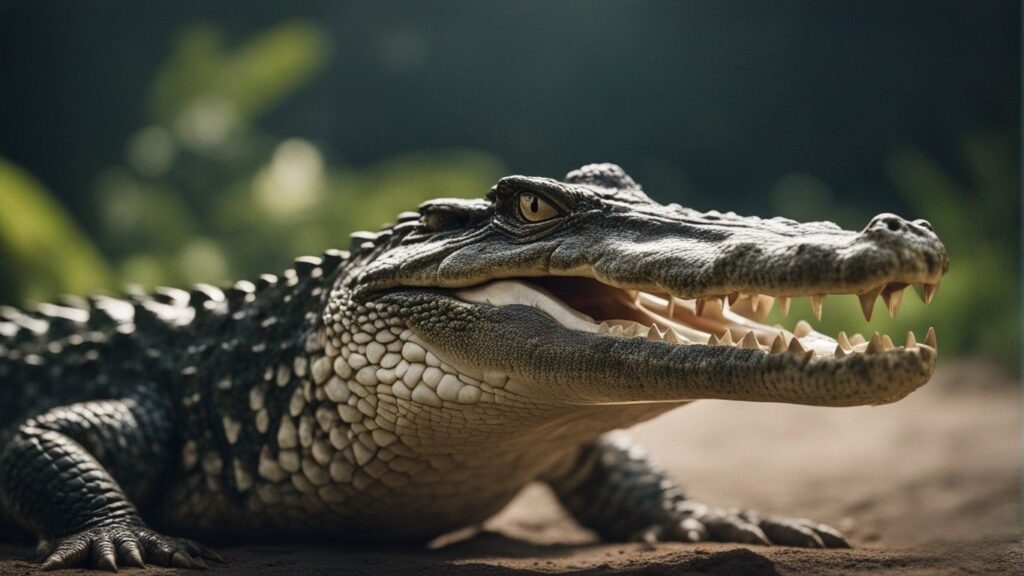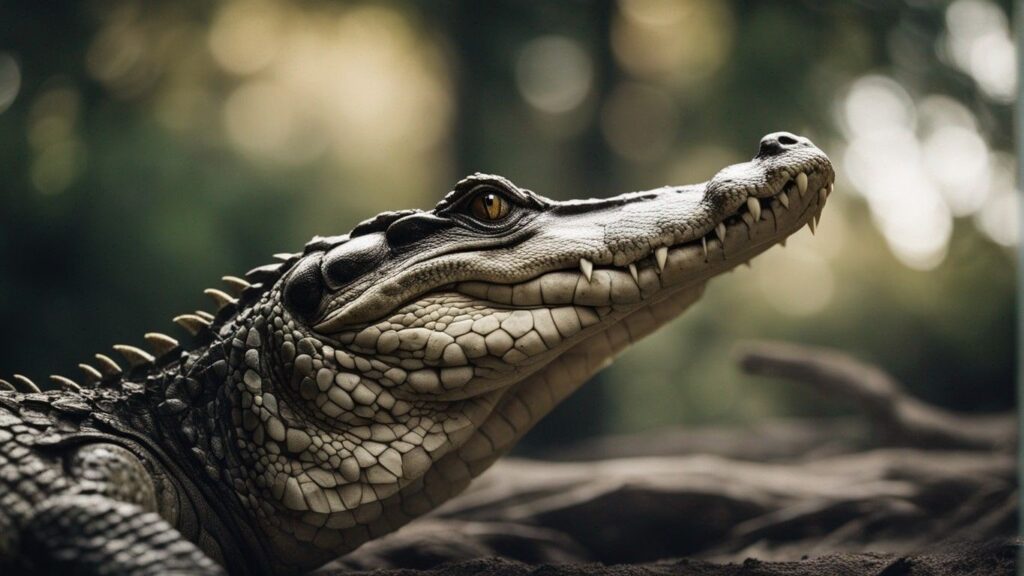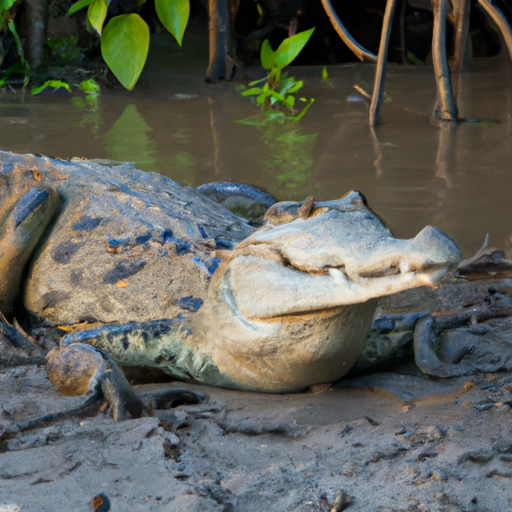Ever wondered where crocodiles’ ears are located? Despite their fierce reputation, these mysterious creatures possess a unique auditory system that sets them apart from other reptiles. While it may not be immediately obvious, their ears are located on the tops of their heads, just behind their eyes. This unconventional positioning allows them to stay submerged in water while remaining alert to any potential threats or prey. In this article, we will explore the fascinating anatomy of crocodile ears and how it contributes to their survival in both land and water environments.

Anatomy of a Crocodile
Crocodiles are fascinating creatures with unique anatomy, both internally and externally. Understanding the various features of a crocodile can provide insights into how they interact with their environment and function in their daily lives.
External Features
Let’s start by examining the external features of crocodiles. These creatures have a streamlined body covered in tough, scaly skin, which acts as a protective barrier against potential threats and helps them maintain their body temperature. They have a long snout filled with sharp teeth, perfectly adapted for their carnivorous diet. Their eyes are positioned on top of their head, allowing them to stay mostly submerged in water while still being able to observe their surroundings.
Internal Features
Moving on to the internal features, we can explore the unique characteristics of crocodile ears. While they may not be immediately visible, crocodiles do have ears, albeit in a different location than what we might expect.
External Ear Features of Crocodiles
Eardrums
Crocodiles have eardrums, also known as tympanic membranes, which are located on the side of their head, just behind their eyes. These eardrums are covered with a layer of skin and are able to detect vibrations in the surrounding water or air.
Ear Openings
The ear openings, or external auditory meatus, are found just behind the eyes and are connected to the eardrums. These openings allow sound waves to enter the ear and be transmitted to the middle and inner ear structures.
Tympanic Cavities
Within the skull of a crocodile, there are tympanic cavities that house the middle ear structures. These cavities are connected to the eardrums and play a crucial role in transmitting sound vibrations from the outer ear to the inner ear.
Internal Ear Features of Crocodiles
Middle Ear Structures
The middle ear structures of crocodiles consist of three small bones known as the columella auris, stapes, and quadrate bone. These bones serve to amplify the sound vibrations received through the eardrums and transmit them to the inner ear.
Inner Ear Structures
The inner ear of a crocodile is responsible for converting sound vibrations into electrical signals that can be processed by the brain. It consists of a complex system of fluid-filled canals and sensory cells, known as hair cells, which detect the movement of the fluid and send signals to the brain for interpretation.
Comparison to Other Reptiles
Difference in Ear Placement
In comparison to other reptiles, crocodiles have a unique ear placement. While most reptiles have their ears located on the sides of their head, crocodiles have their ears positioned higher up, near the top of their head. This adaptation allows them to hear while mostly submerged in water and helps them pinpoint the direction of sound more accurately.
Difference in Ear Functions
Crocodile ears also differ from other reptiles in terms of their functions. Unlike some reptiles that rely primarily on their eyesight for hunting and locating prey, crocodiles heavily rely on their sense of hearing. Their ability to detect vibrations in the water allows them to sense the movement of potential prey even when visibility is limited.
Hearing Ability of Crocodiles
Sensitivity to Vibrations
Crocodiles have an exceptional sensitivity to vibrations in the water. Their eardrums and inner ear structures are specialized to detect even the slightest movements, making them incredibly efficient hunters. This heightened sensitivity allows them to sense the presence and location of potential prey, ensuring their hunting success.
Low-Frequency Hearing
Crocodiles have particularly acute low-frequency hearing, which enables them to detect the low rumblings and vibrations produced by animals in the water. This ability is crucial for their survival, as many of their aquatic prey produce these low-frequency sounds. Whether it’s the footsteps of an approaching creature or the distant call of a potential mate, crocodiles are well-equipped to pick up on these low-frequency signals.
Directional Hearing
The unique placement of crocodile ears plays a significant role in their ability to determine the direction of sounds. By having their ears positioned at the top of their head, they can differentiate between sounds coming from above or below the water surface. This directional hearing helps them locate prey, avoid potential threats, and communicate with other crocodiles.
Evolution and Adaption of Crocodile Ears
Evolutionary History
Over millions of years, crocodiles have undergone significant evolutionary changes, including adaptations to their ears. The unique placement and structure of their ears have evolved to suit their semi-aquatic lifestyle. This evolutionary history has allowed crocodiles to thrive in their specific habitats and fulfill their ecological roles as top predators.
Adaptations to Aquatic Environment
Crocodile ears have undergone specific adaptations to meet the challenges of living in an aquatic environment. The positioning of their ears higher up on their heads, combined with the ability to close their ear openings, allows them to keep water out while submerged. The inner ear structures have also adapted to the changes in pressure associated with diving, enabling the crocodile to detect sound effectively both in and out of water.
Behavioral Significance of Crocodile Ears
Courtship and Mating Calls
Crocodile ears play a vital role in courtship and mating behavior. Males often produce deep, booming sounds, known as bellows, to attract females and establish dominance. These vocalizations can travel long distances through the water and serve as a means of communication between crocodiles during the breeding season.
Environmental Awareness
Crocodile ears provide them with environmental awareness and help them monitor potential threats or changes in their surroundings. By being attuned to sound vibrations, they can detect the movement of other animals, including potential predators or intruders, and respond accordingly. This heightened awareness allows them to ensure both their safety and the safety of their territory.
Hunting and Predatory Techniques
The acute hearing ability of crocodiles plays a crucial role in their hunting and predatory techniques. By detecting vibrations produced by prey, they can precisely locate their target before launching a swift and powerful attack. This heightened sense of hearing also allows them to maintain an element of stealth, ensuring that they remain undetected until the opportune moment to strike.
Role of Ears in Communication
Vocalizations and Acoustic Signaling
Crocodiles use vocalizations and acoustic signaling as a means of communication. By emitting different types of calls, they convey various messages to other crocodiles in their vicinity. These calls can range from deep bellows during the mating season to aggressive hissing or growling sounds as a warning or defense mechanism.
Intraspecies Communication
Within their own species, crocodiles use their ears to communicate with other individuals. By responding to the acoustic signals produced by fellow crocodiles, they can establish territories, defend their territory, and maintain social hierarchies. The ability to interpret and respond to these acoustic signals is crucial for their survival and successful navigation within their complex social structures.
Interspecies Interactions
Crocodile ears also play a role in interacting with other species. They can detect the sounds produced by other animals, including potential prey or predators, and adjust their behavior accordingly. By utilizing their heightened hearing ability, crocodiles can ensure their safety and effectively navigate their environment.
Threats and Conservation
Hunting for Ear Parts
Unfortunately, crocodiles face various threats due to human activities. Illegal hunting for their ear parts, which are considered valuable in certain cultures, poses a significant risk to their populations. This poaching not only disrupts the delicate balance of ecosystems but also endangers the survival of these magnificent creatures.
Environmental Disturbances
Environmental disturbances, such as habitat loss, pollution, and climate change, also impact crocodiles and their hearing abilities. These disturbances can disrupt their natural habitats, introduce harmful substances into their environments, and alter the delicate balance of their ecosystems. Such disruptions can have long-lasting consequences for their survival and overall population health.
Conservation Efforts
To protect crocodiles and ensure their continued existence, conservation efforts are crucial. These efforts include the establishment of protected areas, strict regulations against hunting and poaching, and the promotion of sustainable practices that minimize human impact on their habitats. It is essential to raise awareness and educate the public about the ecological importance of crocodiles and the need to conserve these remarkable creatures.
Scientific Studies and Research
Methods of Studying Crocodile Ears
Scientific studies and research have played a significant role in understanding the anatomy and functions of crocodile ears. Researchers employ various methods, including dissections, experimental studies, and acoustic analysis, to unravel the mysteries surrounding these intriguing creatures. By combining these different approaches, scientists can gain insights into the complex auditory system of crocodiles.
Current Research Findings
Ongoing research continues to shed light on the fascinating aspects of crocodile ears. Recent studies have explored the mechanisms behind their unique hearing abilities, including the specific adaptations of their middle and inner ear structures. Scientists are also delving into the impact of environmental disturbances on crocodile hearing and the potential implications for their survival. By continuously expanding our knowledge, we can better protect and conserve these ancient reptiles.
Final Thoughts
In conclusion, crocodile ears are an integral part of their anatomy and behavior. Their unique placement, enhanced sensitivity to vibrations, and acute hearing ability all contribute to their survival and success as apex predators.
Understanding the various aspects of crocodile ears allows us to appreciate their remarkable adaptations and provides valuable insights into the intricate connections between organisms and their environment.
By recognizing the importance of conserving these magnificent creatures, we can ensure a harmonious coexistence between humans and crocodiles in the natural world.




